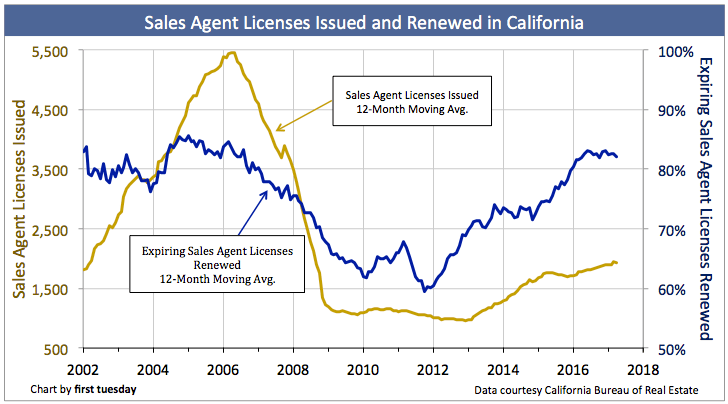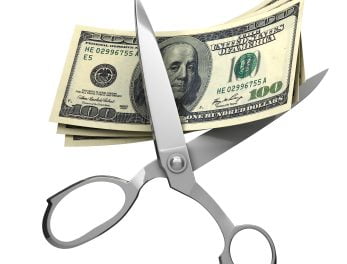Do you plan to renew your real estate license again?
- Yes (88%, 189 Votes)
- No (12%, 26 Votes)
Total Voters: 215
A monthly average of 1,936 new California Bureau of Real Estate (CalBRE) sales agent licenses were issued over the last 12 months ending April 2017. This is up from the 12-month average of 1,780 new sales agents one year earlier.
License renewals remained about the same, with a monthly average of 82% of expiring sales agents renewing their licenses over the 12 months ending in April. This is roughly level with the 12-month average one year earlier.
The direct correlation between home sales volume and agent licensing shows licensing movement changes 6-12 months after a consistent change in home sales volume. Today’s level renewal rate follows a brief uptick, which was directly related to the boost in home prices experienced from the end of 2012 through 2016. This rising sales volume has since fallen back, and led to a leveling in renewals.
A total of 279,500 agents and 133,800 individual brokers are currently licensed by the CalBRE. Expect the number of licensees to decrease slightly through the second half of 2017 due to lackluster sales volume. A substantial increase in sales agents will later occur with the forecasted boom in real estate sales volume and prices. This boom, most likely to occur in 2019-2021, will see the Great Confluence of first-time homebuyers and cash-flush retiring Baby Boomers.
Updated June 30, 2017. Original copy released May 2014.
Chart 1
Chart update 06/30/17
| Apr 2017 | Mar 2017 | Apr 2016 | |
| Sales agent licenses issued 12-month moving average | 1,936 | 1,940 | 1,780 |
| Expiring Sales agent licenses renewed 12-month moving average | 82.0% | 82.5% | 81.9% |
Agent licensing and renewal activity fluctuates from month to month. However, the chart above displays a 12-month moving average of monthly licensing and renewal rates, offering a bird’s eye view of the larger trends.
So what causes the above-average licensee turnover? One answer is that sales volume directly affects active agents’ income. Brokerage income has suffered heavily over the last several years as sales volume remained flat. Members of the public — the source of prospective agents — never hear about sales volume or how well agents are doing. Instead, the media is infatuated with pricing, touting the 10% and 20% year over year home price gains.
Sales agents become licensed
Chart 2
Chart update 06/30/17
The pricing narrative excludes more telling data such as sales volume or the effect of rising mortgage rates. Thus, potential new arrivals see money to be made as prices spiral upward. For them, price momentum undoubtedly means success as a real estate agent is lurking in brokerage offices. Wrong footed, but that is where licensees, old and new, find themselves.
The current influx of fresh troops is insufficient to replace expiring, non-renewing agents. Further, new licensees will slow to a trickle the moment stories emerge about falling prices and increasing foreclosure rates, a near certainty once home sales volume decreases following the increase in mortgage rates in 2017. The pass rate for sales agent and broker applicants taking the state licensing exam has remained stable at 53% and 54% respectively over the past 12 months.
Editor’s note — The percentage of brokers renewing their license is consistently much higher than sales agents, averaging 91% over the past 12 months. With the greater amount of education and experience required to obtain a broker’s license, it’s no wonder the vast majority choose to renew.
As seen in the chart above, the direct correlation between sales volume and agent licensing shows licensing movement changes 6-12 months after a consistent change in home sales volume. This lag time is due to the time period it takes for an agent to:
- complete the required education courses (a minimum of 54 days); and
- pass the agent exam (it takes an average of 1-2 months for CalBRE to process applications before an agent can schedule an exam).
When application volume is high, the CalBRE often experiences processing delays, lengthening the process. New licensing activity is high when the outlook for housing is good, and low during troughs in the housing market. The notable exception occurred following the housing crash, when sales volume rose in 2009, yet agent licensing remained flat. During this time, the word-of-mouth negative outlook on the housing market from the media (not to mention the collection of foreclosure signs on every street) deterred many potential licensees.
Agent licensing peaked in 2005 at over 6,000 new licenses issued in a single month. Since then, licensing has bottomed at around 1,000-2,000 new licenses issued each month. The uptick which began in 2014 is likely due to optimistic views of making a living in the “booming” housing market of 2013-2014.
Agent licensing to fall off
What is expected for agent licensing in 2017 and beyond? The number of newly licensed agents in Q4 2016 was higher than Q4 2015. This is due to the continued increase in home prices experienced since 2013 as a result of historically low mortgage rates. Similarly, the overall number of CalBRE licensees has also increased.
Licensing will begin to languish along with home sales volume in 2017 until the next boom in home sales, likely around 2019-2021. Home sales and prices are expected to rise along with the Great Confluence of first-time homebuyers (members of Generation Y) and Baby Boomers retiring and downsizing.
The future of renewals is mixed
The road ahead for agent renewals is a bit more complex. That’s because renewal rates tend to fluctuate based on how long the agent has held a license.
For instance, first and second time renewals are less likely to renew than those who have held their license for 10+ years. These long-time agents are less likely to let their licenses go due to the hassles of getting licensed all over again if they decide to get back in. On the other side of the scale, Baby Boomers are set to retire in earnest, and many of the older generation will let their licenses expire. The exceptions are those who qualify for CalBRE’s 70/30 rule: if a licensee is 70 years or older and has been licensed in good standing for at least 30 continuous years, they do not have to complete continuing education as part of the renewal process. Thus, they are more likely to continue renewing well into their golden years.
Despite the many facets to forging a forecast for renewals, it’s safe to say that renewals will follow the same trend as licensing. That is, renewals rise following a period of increased home sales, and fall during times of depressed home sales. The only difference is the magnitude of change is lessened for renewals, as seen in Chart 1. That’s because licensees up for renewal know the lengths it takes to obtain a license – and they know choosing not to renew means all that hard work has gone to waste. Even if the housing market isn’t hot now, most will want to be licensed for when it picks up again (and it always does).
For a look at historical licensing trends, see first tuesday’s chart, Newly licensed agent and broker population.




















Creative comments . I learned a lot from the details . Does anyone know where my business could grab a blank CA LIC 215 version to fill in ?
Renew license waits for the right market time.
How about a chart showing the total number of licensees since 2002? Maybe you could put that on a chart that also shows the total population of California over that same time.
Excellent article. Lots of great information.
I agree. Very well written, very informative, and appears to be right on the mark, or close to it.
Very well written article. Very precise and on the mark.